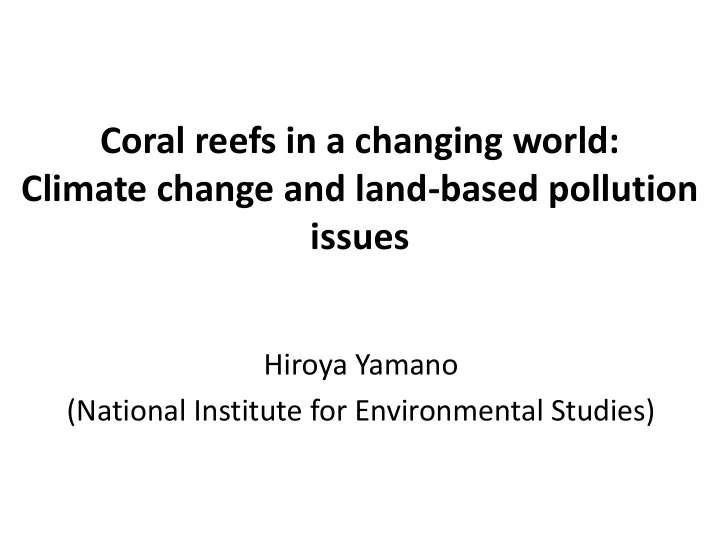

Coral reefs in a changing world: Climate change and land-based pollution issues Hiroya Yamano (National Institute for Environmental Studies)
Outline • Coral reefs at risk • Contribution of remote sensing observations • Climate change and land-based pollution • Framework for sustainable land and coastal ecosystem
Global distribution of coral reefs ReefBase (http://www.reefbase.org) Japan 18˚C in winter 18˚C Coral reefs are an essential component for tropical/subtropical coasts
Importance of coral reefs Photo: H. Kan Photo: H. Kayanne Biodiversity Fisheries Tourism Natural breakwater Island and beach maintenance Estimated value for the ecosystem service $375,000,000,000/year =$6,075/ha/year (Wilkinson, 2002)
Coral cover in the Caribbean region Recent decline of coral reefs Gardner et al. (2003) 50% Sea surface temperature rise Ocean acidification Terrestrial input (sediment/nutrient discharge) Overuse 0 Combined effect of global and regional stresses 1980 1990 2000 year Red: High risk Yellow: Medium risk Blue: Low risk High risk is suggested for fringing reefs “Reefs at Risk” close to land (http://www.reefbase.org)
Multiple stressors on coral reefs CO 2 emission Climate change Precipitation Local-scale factor Global-scale factors -Land-based -Temperature warming pollution -Ocean acidification Coral decline -Sea-level rise Biological factors Land use change -Algal overgrowth - Acanthaster planci outbreak -Overfishing Socioeconomic Population increase Observation methods: Remote sensing -Satellite data -Aerial photographs In situ species Local Local + global -Surveillance camera distribution data 60% at risk 75% at risk -Boat-based video 6 Source: Reefs at Risk revisited
Outline • Coral reefs at risk • Contribution of remote sensing observations • Climate change and land-based pollution • Framework for sustainable land and coastal ecosystem
GEO-BON Japanese Biodiversity Observation Network (J-BON) JAXA AP-BON JAMSTEC J-BON JaLTER/ILTE Genetic diversity R Monitoring JBIF/GBIF Steering WGs Committee Forest Presi dent Networking Interface Agriculture Evaluation/ Inland water Projection Remote Marine Sensing
Satellite remote sensing of coral reefs Original image Classified image Land N 5 km Shiraho Ocean Landsat ETM+: Spatial resolution = 30 m, Accuracy = 64 % N Coral Seagrass Bare substrate (pavement) Bare substrate (submerged sand) 500 m Bare substrate (exposed sand) IKONOS: Spatial resolution = 4 m, Accuracy = 81 % Yamano (2013) In: Coral Reef Remote Sensing
Satellite/airborne remote sensing of lands 1945: Aerial photo 2010: Satellite data (ALOS AVNIR2)
Satellite remote sensing of sediment discharge Satellite data (Terra MODIS)
Surveillance camera 2,000,000 pixels Data transfer by cellular phone network
Boat-based video 2,000,000 pixels Stereo views allows construction of geocoded 3D images
Outline • Coral reefs at risk • Contribution of remote sensing observations • Climate change and land-based pollution • Framework for sustainable land and coastal ecosystem
Sea surface temperatures (SSTs) are rising SST warming in the last 100 yrs around Japan 0.5˚C/100 years JMA IPCC AR4 15
SST in 1998 and coral bleaching
2007 coral bleaching in Japan Japan Live coral cover Green : 50-100 % Yellow : 5-50 % Pink : <5 % 5 km 2003 (before bleaching) 2008 (after bleaching) Source: Ministry of the Environment
Range expansion of corals around Japanese temperate area due to SST warming Maximum speed: 14km/yr Yamano et al. (2011) Geophysical Research Letters
SST warming allows poleward range expansion (north) and bleaching (south) of corals in Japan 19
Multiple stressors on coral reefs CO 2 emission Climate change Precipitation Local-scale factor Global-scale factors -Land-based -Temperature warming pollution -Ocean acidification Coral decline -Sea-level rise Biological factors Land use change -Algal overgrowth - Acanthaster planci outbreak -Overfishing Socioeconomic Population increase Source: Reefs at Risk revisited Local Local + global 20 60% at risk 75% at risk
Increased sediment discharge due to land development 300 m 1962 2010 Paddy field Sugarcane
Increased sediment discharge destroys river and coastal ecosystems Photos provided by Okinawa Prefectural Institute of Health and Environment
A coral reef not affected by sediment discharge ( Sesoko Is., Okinawa ) Bleaching Recovery van Woesik et al. (2011) Coral reefs affected by sediment discharge ( Okinawa Is. ) Reducing sediment discharge may help coral recovery after bleaching 23 Hongo and Yamano (2013) PLoS ONE
Outline • Coral reefs at risk • Contribution of remote sensing observations • Climate change and land-based pollution • Framework for sustainable land and coastal ecosystem
Kume Island, Okinawa, Japan Okinawa
Kume Island, Japan Land development (paddy field to sugar cane) and poor land management resulted in significant sediment discharge
Civil engineering Sediment discharge Land use, Crop growth Red-soil content <10kg/m 3 30-100kg/m 3 >200kg/m 3 10-30kg/m 3 Gima R. Suhara R. Ecology Absence of Semisulcospira <5% coral Presence of Semisulcospira ~10% coral libertina and Luciola owadai cover libertina and Luciola owadai cover
Modeling sediment discharge 5 3 ( qI ) = ⋅ q B A 降雨 0 d q B : Sediment discharge I : Slope q : Surface flow d : Sediment size 地表流による 浸食 + 流送 流域斜面 Application to crop field 5 3 ( qI ) = ∑ ε ⋅ π ⋅ γ ⋅ ⋅ ⋅ Q A L * i i i 0 i B d i Measures to prevent sediment discharge
Identifying sediment source areas to set up countermeasures Setting “green belts” Interview/discussion Cost estimation Searching incentives Socioeconomics
Framework for sustainable management of land and coastal ecosystems Civil engineering Modeling/observing sediment discharge Identifying allowable limit of -> Identification of lands sediment discharge that have large discharge Ecology Biodiversity observation ->Setting conservation goal Setting “green belts” Presenting options for reducing sediment discharge Planning land use Adaptive management Cost estimation People’s incentive ->Sustainable measures Socioeconomics
Summary • Coral reefs are subject to multiple stressors across local (e.g., sediment discharge) to global (e.g., SST warming, ocean acidification) scales • Increased sediment discharge not only causes coral decline but also reduces coral resilience to bleaching---Reducing sediment discharge may help coral recovery after bleaching • A framework to couple ecology-civil engineering- socioeconomics is needed for sustainable management of land and coastal ecosystems
Recommend
More recommend